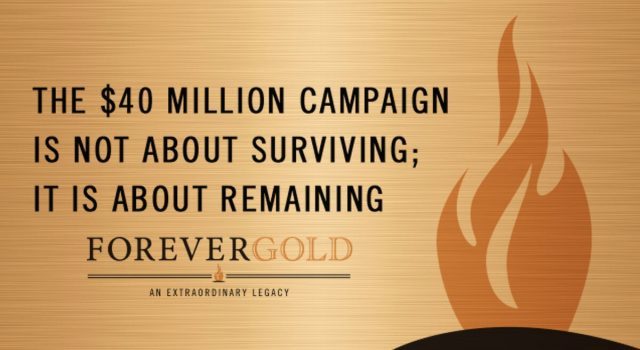ForeverGold
More than a year into the largest fundraising initiative in Brenau history, the ForeverGold campaign has exceeded 63% of its
$40 million goal. How did we get to this point, and where do we go from here?
The news was not merely good. It was great. Brenau University President Ed Schrader and members of the ForeverGold campaign team stood before the spring meeting of the university board of trustees to report on the first year of the public phase of the university’s most comprehensive fundraising initiative ever.
The campaign had raised $24.9 million, about 63 percent of the overall goal of close to $40 million. That total amount included about $18.9 million raised during the so-called “quiet period” plus the roughly $6 million contributed during the first year of the public phase of ForeverGold. Donors and prospective donors appeared to be responding well: Lorry Schrage, the Gainesville business leader who co-chairs ForeverGold, said that he was on his way, after the meeting, to pick up a signed pledge for another $300,000. Matt Thomas, the vice president for external affairs, who oversees all fundraising activities, revealed that in the 2014-15 academic year, every member of Brenau faculty and staff agreed to participate – the first time there had ever been a 100 percent participation rate by full- and part-time employees.
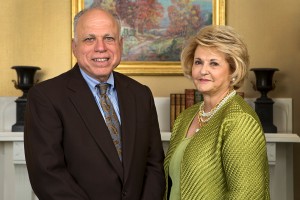
There was more. Schrader and company delivered the report to trustees not long after national news broke that single-gender Sweet Briar College would cease operations this year for financial reasons. Leaders of that institution had stated they would have to have what amounted to a ForeverGold campaign every year just to pay for ongoing operations. Yet here was the leadership of Brenau about to approve the largest budget in its history, an operations plan financed through expansions of both the coeducational programs online and on various campuses as well as those in the Brenau Women’s College.
However, no one hung a “Mission Accomplished” banner across the backdrop of the Brenau Downtown Center theater stage. Schrader, Schrage and Carole Ann Carter Daniel, WC ’68, the ForeverGold co-chair, each in turn pointed out that the successes occurred during the first year of the public phase of the campaign.
“I am very proud of how far we have come,” said Schrage, who is also the trustee who had served as the sole chair of the campaign through most of its “quiet period.” However, he added, “We still have to raise about $15 million to reach our goal for Phase II. I am confident it is something that we can do. In fact, I hope we can go way over that. We’ve still got a few years ahead of us.”
Phase I. Phase II. Quiet phase. Public phase. Comprehensive campaign. Annual fund. Endowment. Operations budget vs. capital campaign. The terms of major fundraising activities can intimidate the uninitiated – particularly when the fundraising activities stretch over several years. What exactly are we raising the money for? If we are doing so well financially, why do we have to raise money at all?
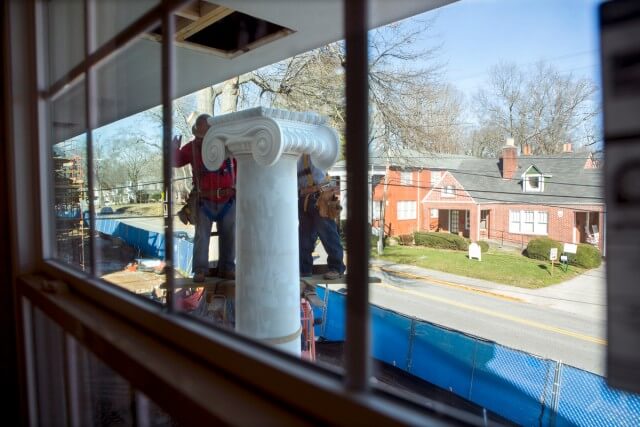
In a dollars-and-cents context, the $40 million ForeverGold campaign across both Phase I and Phase II targets three initiatives: $12.5 million for expansions into health care professional programs; $9.5 million for women’s education initiatives; and $18 million for scholarships, fellowships and other educational program development and improvement throughout the university.
Trustee Daniel, who signed on as co-chair of ForeverGold at the beginning of the public phase, said that major university fundraising campaigns often focus strictly on “bricks and mortar” issues, like constructing stadiums and buildings. Yet she stressed a significant point: ForeverGold Phase I focused heavily on funding highly visible physical improvements, construction and expansions. Phase II targets some less-tactile, yet important, things.
As Daniel observed, Brenau’s Phase II heavily emphasizes expanding endowments for top-quality faculty, student research and student scholarships. It aims in part at women’s education, to provide funding for sorority houses and a residence hall at the 137-year-old undergraduate Brenau Women’s College in Gainesville, athletic facilities for the women’s championship-class intercollegiate sports programs, women’s leadership programs across all education platforms in the university and annual and endowed scholarship programs specifically.
“Now that we have built sorority houses and have started work on a new residence hall,” Daniel said, “we have to concentrate on scholarships, faculty and other things to help us keep those beds and seats filled. We have to make sure that the programs and life experiences we offer at Brenau are the very best that they can be.”
WHAT’S HAPPENING WITH THE WOMEN’S EDUCATION INITIATIVE
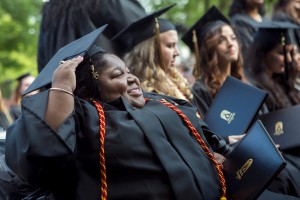
NOW THE HARD PART
So what is a campaign? Many terms describe the concept and, depending on who you talk to, some can be blunt and to the point (“raising money”) while others may be a bit flowery and euphemistic (“a multiyear initiative to ensure sustainable resources for mission-critical endeavors”).
Like ForeverGold, campaigns usually are divided into two phases: the “quiet phase” or “silent phase” and the public phase, each of which may last several years. The term “quiet phase” belies what happens during that portion of the campaign. You are still raising money, and you are anything but quiet.
“It is something of the ‘proof of concept’ phase,” explained Robert Shippey, the senior development officer at Brenau and ForeverGold campaign manager. “Before you set out to raise money for the causes you specify, you have to prove that you can. Not surprisingly, the best way for proving that you can raise substantial sums of money is by raising substantial sums of money – or getting substantial commitments, starting with those who are closest to the campaign and the institution.”
Brenau trustees technically approved the Phase I launch just in time for the economic downturn of 2007-08, which strung out the initial goals. By the time Schrader announced the beginning of the public phase in March 2014, the university already had raised money to pay for a variety of major ongoing activities, many of which were widely publicized anchors of Phase I.
ForeverGold focuses on women’s education, but it also propels all university academic components to a broader range of engagement and achievement. That’s what will keep the women’s college alive and thriving.”
– Carole Ann Daniel, ForeverGold Co-Chair
The centerpiece of the first phase also included the very public redevelopment of the city of Gainesville-owned entertainment and meeting venue into the Brenau University Downtown Center, the home of a new doctor of physical therapy program as well as The Manhattan Gallery of modern art. That first phase also encompassed increasing the university’s endowment and improvements to its well-respected nursing program facilities.
During the quiet phase, South Carolina-based Pacolet Milliken Enterprises, Inc., donated a 16.8-acre tract of land for the development of a multipurpose athletics park at the site of the historic New Holland textile mill village about two miles northeast of the university’s historic campus in Gainesville. Close to 20 percent of the Women’s College student body participates in intercollegiate sports. The university envisions on the site a $4.4 million project that includes “home field” facilities for the Golden Tigers soccer, softball, and track and field. There also will be additional public access for both university and community use. Local government authorities gave clearance to begin construction in early 2015, and the university hopes to have the first piece, the softball-related portion, completed when students return for fall semester.
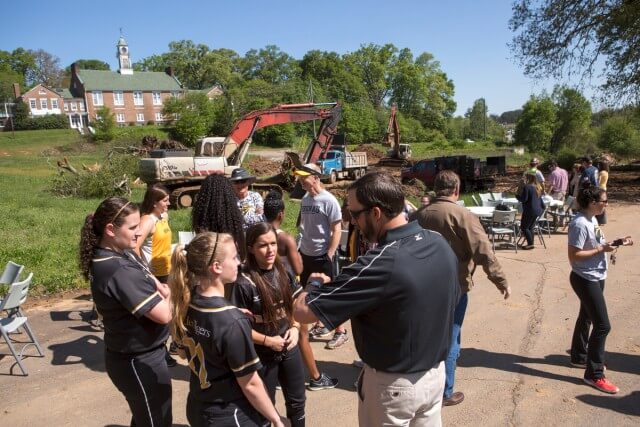
Brenau Trustee Doug Ivester and his wife, Kay, both grew up in the New Holland community and, in fact, first met in the elementary school that once occupied the site of the athletics complex. They provided funding for initial development of what is now named Ernest Ledford Grindle Athletics Park – in honor of Kay Ivester’s late father. That work includes a softball field, parking, bleachers, field house and other improvements. ForeverGold Phase II comprises the balance of the park’s development – including grounds for track and field as well as soccer.
Philanthropy experts often regard the public portion of any campaign as the hardest part. It is when you intensify solicitations and reach out to prospective donors – individuals, corporations and foundations – who perhaps have not contributed to the university before. You return to donors who contributed in the past, including those who stepped up early in the quiet phase, often asking them to make bigger investments in the future of the university.
The public phase seeks investments for which donors may not recognize immediate results – thus requiring them to “see” your vision as well as find chords that resonate with their philanthropic philosophies.
Because both phases of the campaign have run parallel with operational execution of the university 2025 strategic plan, the university financed time-sensitive projects with the understanding that future campaign efforts ultimately would pay for those activities. That included reconstruction of the Downtown Center, including the anatomy lab that opened for business in May 2015. It arranged to pay in advance to build four new sorority houses and a large residence hall, with occupancies scheduled in summer and fall of 2015.
Another factor about campaigns: Projects may “jump the fence” between the silent phase and the public phase. All three aspects of ForeverGold – expanding health care professional programs, women-oriented activities and bolstering scholarship and faculty endowments – overlap from one phase to the next.
WHAT’S HAPPENING WITH THE HEALTH SCIENCES INITIATIVE
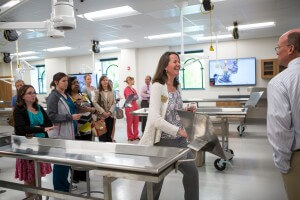
Take the Downtown Center development, for example. Months before Schrader and the campaign leaders made their annual report to trustees, ForeverGold co-chair Lorry Schrage, his wife, Sherry, and her mother, Muriel Nathan, provided the $125,000 lead gift, activating a pledge from an anonymous Atlanta donor that technically closed out Phase I fundraising for the Downtown Center. However, in the late spring of 2015, the campaign completed a $300,000 gift agreement with John R. Cleveland, of Gainesville, to name the Cleveland Lobby of the new physical therapy wing of the Downtown Center in honor of his mother, Mary, and in memory of his father, Ralph, a longtime Brenau trustee. The lobby had been completed and put into service about a year earlier.
“There is a lot of juggling in a comprehensive campaign like ForeverGold, because we are donor-centered in our approach,” Thomas explained. “For example, we will get a pledge for a gift to complete a building to come in installments over several years, so we have to arrange interim financing to pay for the now and retire the debt as the funds come in. Donors sometimes look at taxes or cash flow or investment consequences, but we can work with them to structure their generosity in ways that best suit them.”
Although the major Phase I Downtown Center renovations included the subdivision of the large arena into two stories of usable space, the new second floor remained undeveloped at the end of Phase I. A key component of Phase II of ForeverGold will be finishing the second floor.
Other Downtown Center donor opportunities include the planned public clinic-type facility for physical therapy and continuing expansion of graduate and undergraduate programs in health care professional preparation – including a proposed undergraduate major in athletics training projected to begin in 2016.
MISSION CONTROL
Early in the 2014-15 academic year, the ForeverGold volunteer campaign committee kicked off its work for the Phase II public campaign at a Downtown Center organizational meeting amid visible evidence of the work that already was in progress.
The group met in a new classroom named for the donors who helped furnish it, Brenau Trustee Gary Riley and his wife, Georgine. Brenau President Schrader, addressing the group, pointed to the wall-mounted MondoPad, which resembles a giant screen TV but which is an elaborate touch-screen computer connected with many others around the university. The device, Schrader explained, “contains more technology than what it took to fly the Apollo mission to the moon.” That and other technology now in use around the university system started with a “quiet phase” gift from the Lettie Pate Evans Foundation, one of several philanthropic organizations born of the Coca-Cola fortune.
Assembled committee members represented a diverse mix of Brenau extended family members – faculty, staff, trustees, Women’s College alumnae, graduates of other programs – men and women of all ages. Although many had helped raise money before for specific projects related and unrelated to Brenau, few in the room had ever participated in anything like ForeverGold.
“This is the first comprehensive campaign in our university’s history,” Schrader told the group. “There have been previous multimillion-dollar campaigns, but none this large.” Earlier campaigns, he explained, were all need-specific -– to raise funds for projects like the Burd Center for Performing Arts or the Trustee Library.
WHAT’S HAPPENING WITH THE STUDENT ACCESS AND EXPERIENCE INITIATIVE
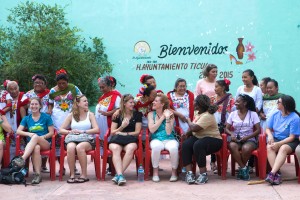
ForeverGold also marks a dramatic institutional extension of the Brenau legacy and history through all areas of the university – starting with a play off the unique name, Brenau, and motto, “As gold refined by fire,” that H.J. Pearce applied to his small women’s college in about 1900.
“The motto and the Brenau ideal now permeate the entire university,” Schrader continued. “It is what we strive to be – not only with the Women’s College but also with all of our operations. The foundation of the Women’s College has brought us to this point. Truly, our growth would mean less if it were not founded on and entwined with that secure heritage of the Women’s College.”
Schrader acknowledged that in the past, some donors – both alumni and foundations – have been somewhat compartmentalized in their thinking about supporting Brenau. For example, they might be perfectly willing to support some program for the Women’s College but not at all receptive, say, to supporting expanding to a new coeducational operation in Jacksonville. ForeverGold, he added optimistically, is helping people recalibrate their thinking about supporting Brenau.
“The ForeverGold campaign is a case in which you actually can have your cake and eat it, too,” Schrader explained. “A really good way to support the Women’s College at Brenau is to invest in one of our coeducational graduate or undergraduate programs that will generate the surplus revenues that we use to enhance a strong Women’s College.”
Is the message getting through at the end of year one of the six-year campaign?
ForeverGold has a long road still, said Brenau External Relations Vice President Thomas, “but the markers are clear. We are seeing resolute support and incredible generosity from trustees and campaign leadership. We are seeing dramatic shifts in support from alumni, employees, parents and friends who, with their generosity, are responding and embracing Brenau’s compelling vision with gifts at every level. ForeverGold is a historic undertaking, but as Lorry Schrage says, ‘This is something we can do.’”
